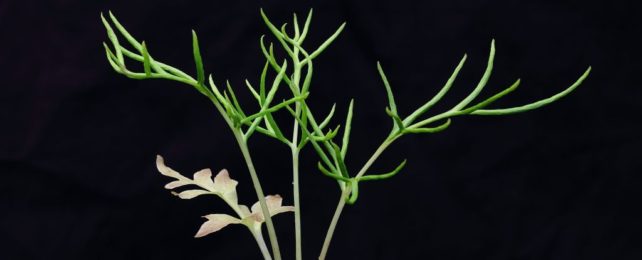There's something really peculiar about ferns.
Their DNA is weird and complex. In fact, one species of fern – Ophioglossum reticulatum, or the adder's tongue fern – holds the record for the multicellular organism with the most number of chromosomes. Around 720 pairs of chromosomes can be found in most of its cellular nuclei.
Well, turns out we were right to be suspicious.
After years of painstaking work, scientists have finally sequenced the gargantuan genomes of three different homosporous ferns, revealing that these pernicious plants have not only been hoarding DNA, they've been stealing it from other organisms – and doing so for millions of years.
"Every genome tells a different story," says geneticist Doug Soltis of the Florida Museum of Natural History, co-author of one of the papers.
"Ferns are the closest living relatives of all seed plants, and they produce chemical deterrents to herbivores that may be useful for agricultural research. Yet until now, they've remained the last major lineage of green life without a genome sequence."
The genomes of the three ferns have been described in three separate papers.
A paper on the flying spider-monkey tree fern (Alsophila spinulosa) was published in May in Nature Plants. This week, it is joined by papers on the maidenhair fern (Adiantum capillus-veneris) and the C-fern (Ceratopteris richardii), which has been studied as a model organism for decades.
Soltis contributed to the C-fern paper, as part of a team of scientists from 28 institutions around the world. Theirs was a Herculean effort, taking more than eight years to piece together the C-fern genome.
The result: a genome comprising 7.46 gigabases of DNA in its 39 chromosome pairs – more than twice the size of the human genome. And it's yielded some pretty interesting surprises, the researchers report.
In the past, scientists have attributed ferns' immense genomes and high chromosome count to repeated rounds of whole-genome duplication, in which an organism's offspring accidentally inherits additional copies of the organism's entire genome. This is common in plants and can confer some benefits, such as rapid evolution and divergence.
However, organisms that experience this tend to go through a short period of adjustment, in which most of the duplicates are lost, resulting in a more normal genome. Unlike that of ferns.
"This has been a major point of discussion for the last half-century and has led to all kinds of conflicting results," says botanist and co-author Daniel Blaine Marchant of Stanford University.
"Trying to figure out the evolutionary process underlying this paradox is incredibly important."
The answer was in the DNA of C. richardii. Rather than the identical sections of DNA that would be expected if duplication was involved, the fern's chromosomes contain a scrappy mishmash of repetitive snippets and scraps, genetic debris that has accumulated in the plant.
Eighty-five percent of the C. richardii genome is made up of these transposons, DNA sequences that can move around, and that proportion was also observed in A. capillus-veneris.
"The functional genes are separated by large amounts of repetitive DNA," says botanist Pam Soltis of the Florida Museum of Natural History.
"And although we're not yet sure how the Ceratopteris and other fern genomes got so big, it's clear that the prevailing view of repeated episodes of genome duplication is not supported."
However it happened, it seems to suggest that ferns are simply inefficient at shedding junk DNA. Instead, they keep it around indefinitely, like a hoarder who simply doesn't know when they might have a use for that drawer full of dried-up pens.
But the team also found evidence that C. richardii is a sneaky little DNA thief.
In the fern's genome are defenses against a particular toxin that punches holes in a cell's membrane. These defenses are usually found in bacteria – suggesting that the fern acquired it from bacteria via a process called horizontal gene transfer (which is actually quite common among bacteria).
Copies of these defense genes show up in different parts of the plant, suggesting that this transfer happened multiple times. So the fern does seem to be deriving some benefit from the fruits of its spoils, and likely that benefit is also defensive, the researchers suggest.
And rather surprising and ingenious, too.
"The mechanisms behind horizontal gene transfer remain one of the least investigated areas of land plant evolution," Soltis says.
"Over evolutionary timescales, it's a bit like winning the lottery. Any time a plant is wounded, its interior is susceptible to invasion from microbes, but for their DNA to be incorporated into the genome seems amazing."
You'll never look at your ferns the same way again.
The papers on A. spinulosa, A. capillus-veneris, and C. richardii have been published in Nature Plants. They can be found, respectively, here, here, and here.
